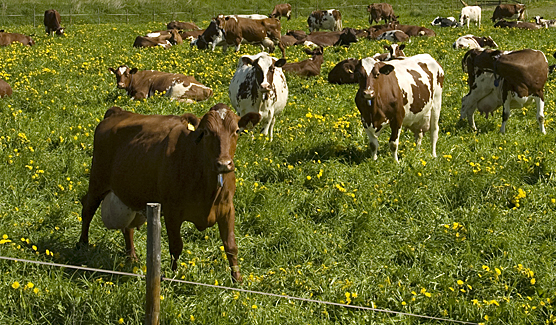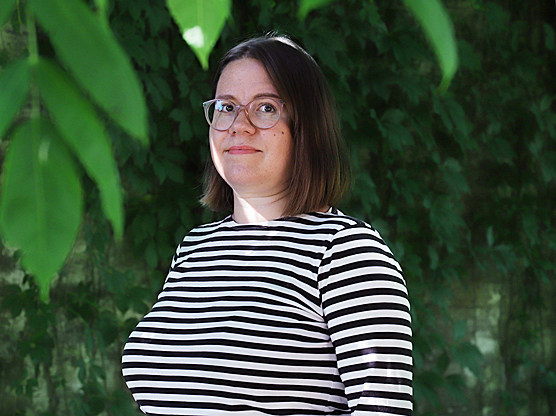Press release 2022-08-23 at 12:19

Dairy cattle breeding aims for invisible cows: animals that are as easy as possible. © SYKEkuva/ Riku Lumiaro
New doctoral dissertation examines livestock breeding from the perspective of social science. Breeding goals impact cattle, dairy farmers, and the relations between farmers and cows. Livestock breeding currently aims for invisible cattle, animals that are easy to manage. This breeding goal guides farmers to intensify their production and encourages farmers to focus on herd management rather than individual animals.
Annika Lonkila, who works as senior researcher at SYKE, defends her thesis in the University of Eastern Finland on August 31.
In Finnish dairy cattle breeding, the goal is to produce invisible animals. Invisible cows do not demand attention for humans. They are healthy, obedient, easy, and collaborative in their body and behaviour, especially suitable for larger herds and automated milking parlours. The goal of invisibility has been used especially to market breeding services based on genomic knowledge.
“Invisibility allows for more distanced relations between dairy farmers and cattle. Some of the farmers I interviewed welcomed this change, but others hoped that they could concentrate on smaller herd size with closer human-animal relations”, says Annika Lonkila
Breeding targets stem from political and strategic goals
New dissertation explores the tensions and conflicts in the breeding goal of invisibility, and showcases that breeding targets are political and strategic. Breeding goals impact the future of food production.
Breeding goals are entangled in different values and economic targets. “It is important to foreground what these values are, especially in the current situation where very different visions for the future of food production are being proposed. Also social scientific and ethical viewpoints matter here”, says Annika Lonkila.
Livestock breeding has not yet been on the radar social scientific research in Finland. In creating a more sustainable food system, breeding is often seen to have a rather technical role, e.g. in improving the feed efficiency of cattle. Social scientific research can explore what the role of breeding in the sustainable food transition could look like on broader terms.
New requirements for dairy cattle
Genomic knowledge enables the goal of invisibility, because it allows for controlling hereditary progress better and decreases unpredictability. Livestock production can be optimized in a more detailed manner.
The goal of invisibility creates new requirements for cows. Invisible cows are healthy, obedient, easy, independent, and collaborative. They are expected to perform well while being milked, when they calve, and during their daily life in the herd.
Invisible animals should not be too shy, too social, or too playful. Health and fertility issues create too much work for the farmer and can cause the animal to be removed from the herd. At the same time, there is an internal conflict, as high production targets correlate negatively with fertility.
Dairy farmers have different reactions to changing breeding practices
The data of the dissertation consists of interviews with breeding company experts, researchers, and dairy farmers. There are 26 interviewees. The researcher also visited 11 dairy farms and analysed 111 articles in the Finnish breeding magazine, Nauta.
Genomic breeding practices have moved expertise on breeding further away from the farm and the hands of the farmer. The invisible cow guides farmers to become more efficient, to move “from the milking stool to the calculator”, and focus on herd management rather than individual animals.
Invisibility allows for more distanced relations between dairy farmers and cattle. Some of the interviewed farmers welcomed this change, but others hoped that they could concentrate on smaller herd size with closer human-animal relations.
“These alternative dairy farmer identities could be belittled in the narratives of the breeding companies, because it was seen that these farmers do not participate fully in improving the profitability of Finnish dairy production”, says Annika Lonkila.
”Yet some interviewed farmers were willing to settle for lower production levels in order to improve cattle fertility and health and the meaningfulness they found in their work. Lower production targets are also in the interest of the animals. However, the low profitability of Finnish dairy farms makes the situation difficult”, Lonkila says.

I hope that my work will help raise livestock breeding on the agenda in discussing the future of our food production and the kind of animals we produce for our food, says Annika Lonkila. © Saara Sivonen/SYKE
It is important to make room for alternative production practices
“Instead of encouraging both farmers and cattle to be come more efficient, it would be important to examine the root causes of the structural issues in agriculture, such as the profitability crisis. It is crucial that there is room for alternative production goals and practices in the future”, says Annika Lonkila.
“I hope that my dissertation will highlight that livestock breeding needs to be foregrounded in public discussions about the future of food production. This is increasingly important as livestock production faces many pressures and challenges, for example in relation to climate change, security of supply, and profitability”, Lonkila emphasises.
More information
Annika Lonkila, MSc, LLM, Senior researcher, Finnish Environment Institute SYKE
firstname.lastname@syke.fi, phone +358 295 252 032
Annika Lonkila defends her thesis on Wednesday 31.8.2022 at 18 p.m. in University of Eastern Finland, Faculty of Social Sciences and Business Studies. The event is in English.
Address: Auditorium M100, Metria, Yliopistokatu 7, Joensuu. You can also follow the defence on Teams
Defense: Making invisible cows? – Genomic knowledge and more-than-human agency in Finnish dairy breeding